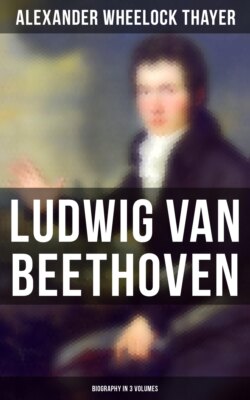Читать книгу Ludwig van Beethoven (Biography in 3 Volumes) - Alexander Wheelock Thayer - Страница 24
На сайте Литреса книга снята с продажи.
ОглавлениеI have a great deal to do or I would before this have transcribed the sonata which I promised you long ago. It is a mere sketch in my manuscript and it would be a difficult task even for the clever and practised Paraquin to copy it. You can have the rondo copied and return the score to me. It is the only one of my things which is, in a manner, suitable to you.
May these words not be paraphrased thus: “As to the sonata which I played at your house and of which I promised you a copy—it is in my manuscript hardly more than a sketch, so that I could not trust it to a copyist, not even to Paraquin, and I have not had leisure to transcribe it myself.” And, finally, the closing lines of a short article in the “Jahrbuch der Tonkunst für Wien und Prag,” 1776—which notice was not written later than the spring of 1795, nine or ten months before the publication of the Sonatas Op. 2—are pregnantly suggestive: “We have a number of beautiful sonatas by him, amongst which the last ones particularly distinguish themselves.” These works were, therefore, well-known in manuscript even at the time when he was busy with his studies under Haydn and Albrechtsberger.
III. If in spite of the above it still be objected that the opera 1 to 15, or 20, as you please, are of a character beyond the powers of Beethoven during his Bonn life, who knows this to be a fact? Has such an objection any other basis than a mere prejudice?
Evidences of Early Activity
A fanciful theory has exhibited Beethoven to us as a rude, undeveloped genius, who, being transferred to Vienna and schooled two years by Haydn and Albrechtsberger, then began with the Trios Op. 1, wrought his way upward in eight years through the twenty-three compositions of opera 2 to 14 in a geometrical progression to the first pianoforte concertos, the ballet “Prometheus” and the Symphony in C! It is, however, known that in March, 1795, Beethoven played his Pianoforte Concerto in B-flat in Vienna, shortly afterward published the Trios, Op. 1, and in 1796 composed the two sonatas for pianoforte and violoncello in Berlin. A young man who at the age of 24 or 25 could give the public two such concertos could hardly have been such a rough diamond only three or four years before.
IV. However convincing the preceding propositions may seem to the ordinary reader, the critical student of musical history justly demands something more. It is not enough for him to know that Op. 19 was composed before the publication of Op. 1; that Op. 2 is in part made up from the Pianoforte Quartets of 1785; that the Quintet Op. 4 is an arrangement of the “Parthia” in E-flat for wind-instruments afterwards published as Op. 103, and is now proved to belong to the Bonn period, and that a whole movement of the funeral cantata found its way into “Fidelio”—the argument is to him like an arch without its keystone until one or more of the important works be named specifically as Bonn compositions and proved to be such.[62]
